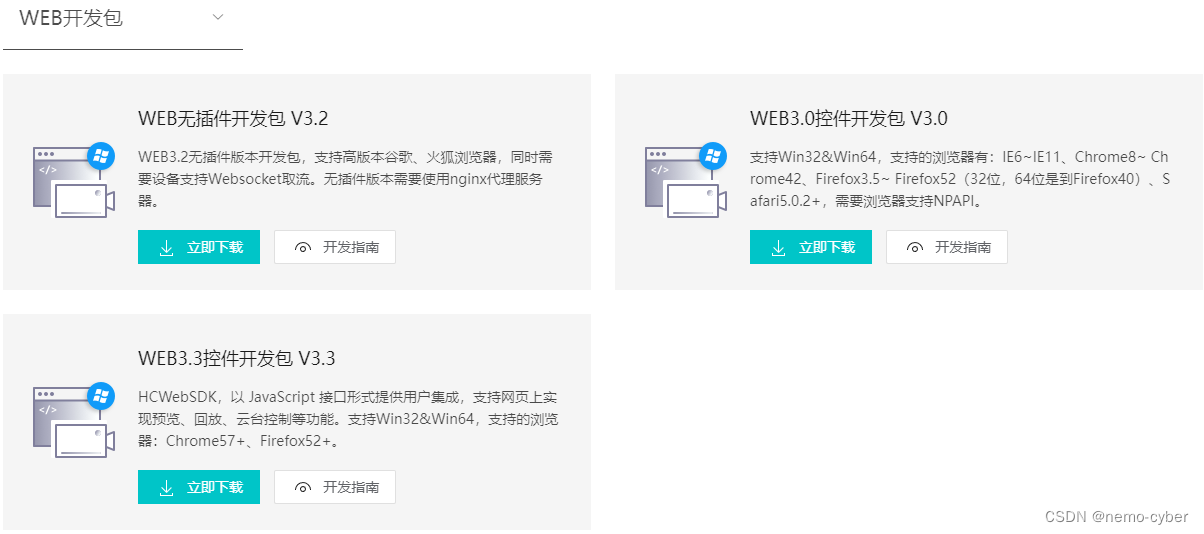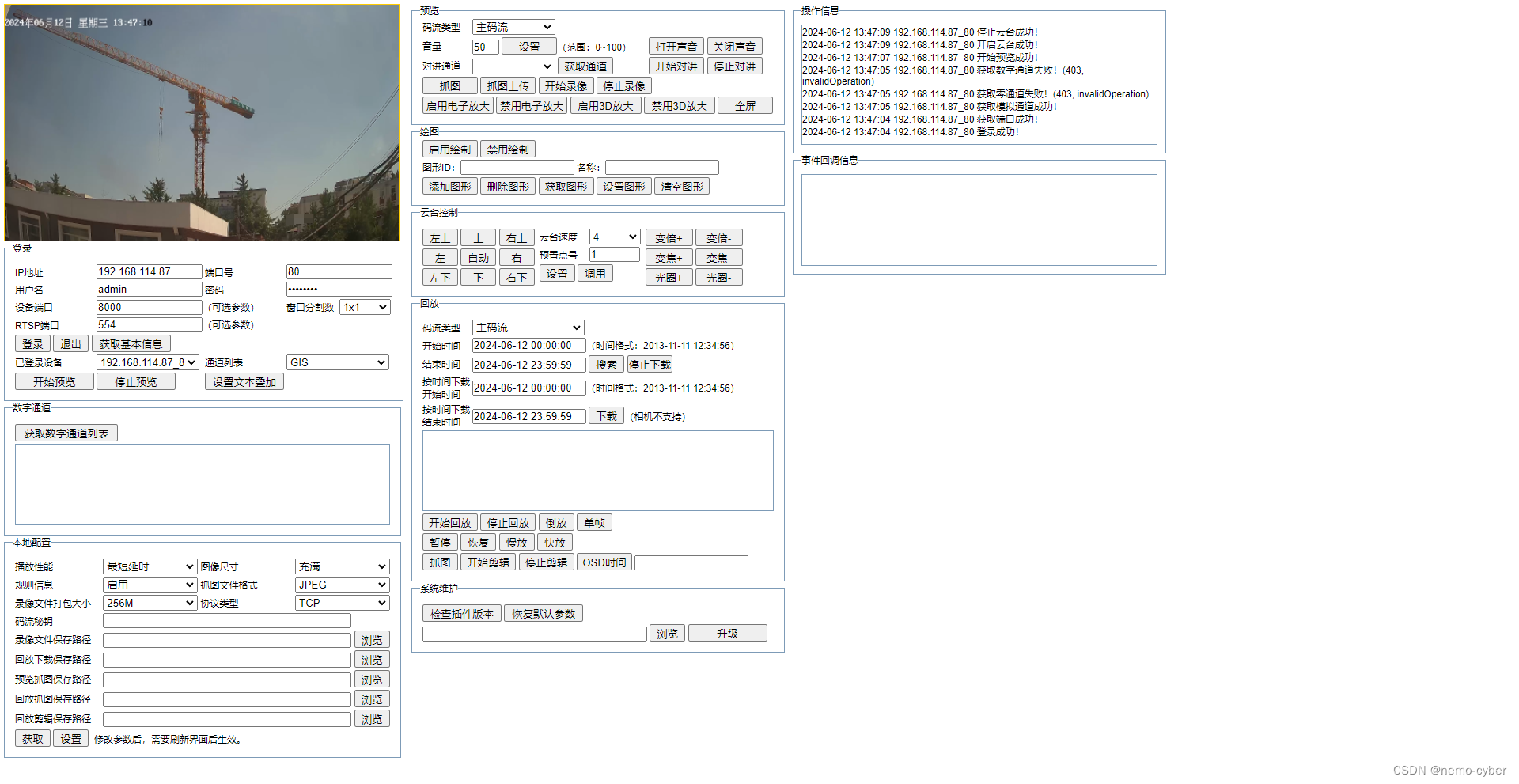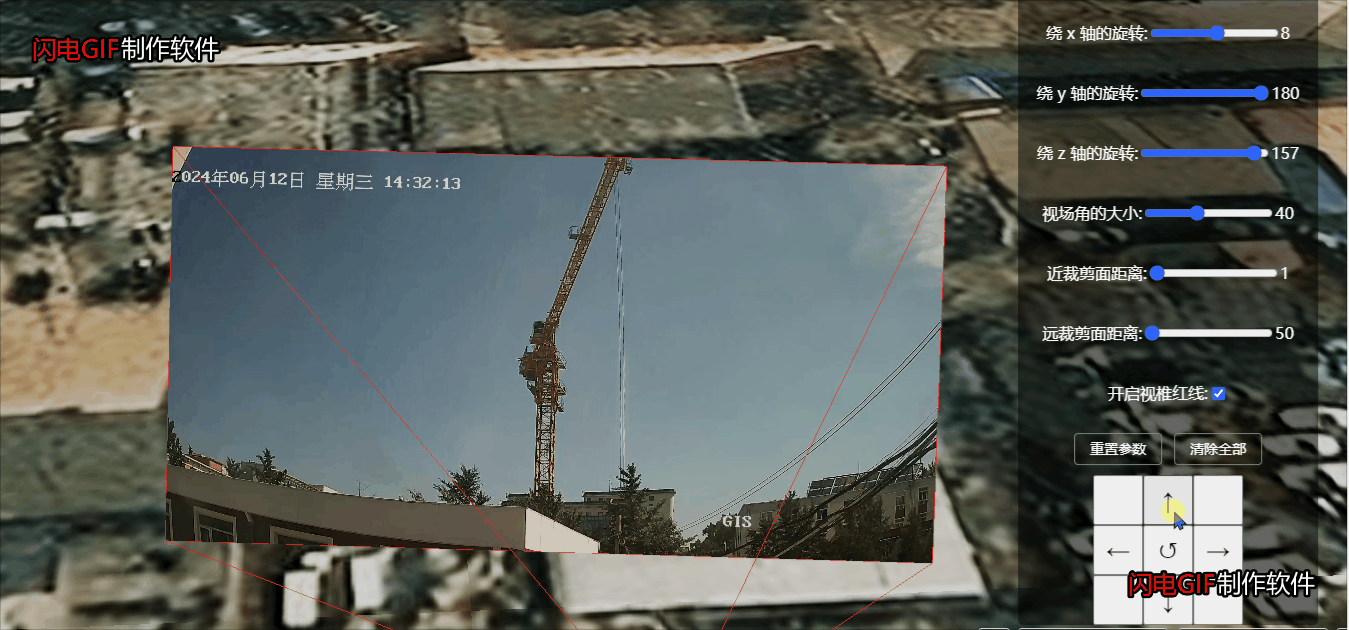1.硬件设备与视频流接入
如需要一步上一篇博客
2.海康WebSDK
海康管网选择对应的sdk下载
海康开放平台海康威视合作生态致力打造一个能力开放体系、两个生态圈,Hikvision AI Cloud开放平台是能力开放体系的核心内容。它是海康威视基于多年在视频及物联网核心技术积累之上,融合AI、大数据、云计算等技术,为合作伙伴提供的一个二次开发及创新的平台。![]() https://open.hikvision.com/download/5cda567cf47ae80dd41a54b3?type=10&id=4c945d18fa5f49638ce517ec32e24e24 有下图三个版本的开发包,注意看相关说明,如下图:
https://open.hikvision.com/download/5cda567cf47ae80dd41a54b3?type=10&id=4c945d18fa5f49638ce517ec32e24e24 有下图三个版本的开发包,注意看相关说明,如下图:

之前在网上看到有用V3.2的开发包写的博客教程,如果有需要的移步此处
海康威视web3.2开发包开发使用说明_海康isapi文档-CSDN博客文章浏览阅读2.7k次。首言:通过海康威视的最新web开发包工具进行js调用引入至vue项目中,实现监控设备的对接,监控功能的实现。3.2无插件js库同时支持插件安装的模式。目录首言:一、海康威视开发平台:?1、下载开发工具包文档2、专家支持在线咨询问题二、3.2无插件开发1、需要引用的js包2、开发api3、注意事项三、在VUE项目中多个页面引用插件进行监控视频实时显示1、把初始化过程抽象为一个组件2、在不同页面中进行调用四、其他说明1、无插件开发包必须使用nginx代理(无论是测试还是生产环境)_海康isapi文档https://blog.csdn.net/asdfadafd/article/details/123397672在vue中使用海康web3.2插件连接云台摄像机_vue3 海康 mousedownptzcontrol(iptzindex)-CSDN博客文章浏览阅读493次。在index.html文件中先引入需要的脚本。创建一个摄像机组件(复制粘贴直接可用)_vue3 海康 mousedownptzcontrol(iptzindex)
https://blog.csdn.net/qq_42556623/article/details/136883903?spm=1001.2014.3001.5501 因为我的设备不支持websocke流,这里我选用的是WEB3.3控件开发包V3.3。
如果不清楚自己的设备是否支持websocket,咨询官方客服,如果不支持websocke使用3.2版本的开发包会报错。
3.官方示例
下载完成之后可以用nginx或anywhere发布后登录查看其中的demo示例,
输入设备的IP地址、端口号、用户名、密码登录并预览,页面如下图:

4.开发包的使用
(1)安装控件HCWebSDKPlugin.exe
![]()
(2)引入静态资源文件
在开发包里找到红框中的三个文件,放在前端静态资源文件夹内发布,并在index.html中进行引入。


5.针对官方示例的二次开发
5.1海康demo中的功能封装
刚开始我抱着将websdk进行改写的想法,但是后来发现demo中的代码量实在是过于大,于是将其中需要的部分拎出来进行了封装。其实demo中的代码看起来量比较大,但是把没用的东西删除掉之后,逻辑挺清晰的。
个中原因,不方便贴源码,此处截取涉及到的相关代码,如需要自行取用。
(1)初始化插件参数及插入插件
// 初始化
init() {
// 初始化插件参数及插入插件
WebVideoCtrl.I_InitPlugin({
bWndFull: true, //是否支持单窗口双击全屏,默认支持 true:支持 false:不支持
iWndowType: 1,
cbInitPluginComplete: function () {
WebVideoCtrl.I_InsertOBJECTPlugin("divPlugin").then(() => {
// 检查插件是否最新
WebVideoCtrl.I_CheckPluginVersion().then((bFlag) => {
if (bFlag) {
alert("检测到新的插件版本,双击开发包目录里的HCWebSDKPlugin.exe升级!");
}
});
}, () => {
alert("插件初始化失败,请确认是否已安装插件;如果未安装,请双击开发包目录里的HCWebSDKPlugin.exe安装!");
});
}
});
setTimeout(() => {
this.login();
}, 1000);
}(2)登录
// 登录 将下边的四个参数替换成你自己的
login() {
var szIP = "IP",
szPort = "Port",
szUsername = "username",
szPassword = "password";
if ("" == szIP || "" == szPort) {
return;
}
var szDeviceIdentify = szIP + "_" + szPort;
WebVideoCtrl.I_Login(szIP, 1, szPort, szUsername, szPassword, {
timeout: 3000,
success: function (xmlDoc) {
console.log(' 登录成功',)
startRealPlay()
},
error: function (oError) {
console.log(' 登录失败',)
}
});
// 预览
var startRealPlay = function () {
WebVideoCtrl.I_StartRealPlay(szDeviceIdentify, {
success: function () {
console.log("预览成功");
},
error: function (oError) {
console.log("预览失败");
}
});
};
}(3)云台控制
// PTZ控制 9为自动,1,2,3,4,5,6,7,8为方向PTZ
mouseDownPTZControl(iPTZIndex) {
if (9 == iPTZIndex && this.g_bPTZAuto) {
this.iPTZSpeed = 0;// 自动开启后,速度置为0可以关闭自动
} else {
this.g_bPTZAuto = false;// 点击其他方向,自动肯定会被关闭
}
WebVideoCtrl.I_PTZControl(iPTZIndex, false, {
iPTZSpeed: this.iPTZSpeed,
success: function (xmlDoc) {
if (9 == iPTZIndex && this.g_bPTZAuto) {
console.log('停止云台成功')
} else {
console.log('开启云台成功')
}
if (9 == iPTZIndex) {
this.g_bPTZAuto = !this.g_bPTZAuto;
}
},
error: function (oError) {
console.log('开启云台失败')
}
});
}(4)停止云台控制
// 方向PTZ停止
mouseUpPTZControl() {
WebVideoCtrl.I_PTZControl(1, true, {
success: function (xmlDoc) {
},
error: function (oError) {
console.log('停止云台失败')
}
});
}(5)将上边这几个函数封装在一个class类中
目前只写了初始化、登录、云台控制,如需要其他的接口方法,可自行进行拓展。
export default class CameraController {
constructor() {
this.g_bPTZAuto = false;
this.iPTZSpeed = 4
}
init(){}
....
}5.2类调用与云台控制实现
个中原因,不方便贴源码,此处截取涉及到的相关代码,如需要自行取用。
(1)vue代码中撰写云台控制按钮代码
<div id="divPlugin" width="500" height="300" display="none"></div>
<div class="control-grid">
<button @mousedown="mouseDownPTZControl(5)" @mouseup="mouseUpPTZControl()"
class="control-button up-left">
<!-- ↖ -->
</button>
<button @mousedown="mouseDownPTZControl(1)" @mouseup="mouseUpPTZControl()"
class="control-button up">↑</button>
<button @mousedown="mouseDownPTZControl(7)" @mouseup="mouseUpPTZControl()"
class="control-button up-right">
<!-- ↗ -->
</button>
<button @mousedown="mouseDownPTZControl(3)" @mouseup="mouseUpPTZControl()"
class="control-button left">←</button>
<button @mousedown="mouseDownPTZControl(9)" @mouseup="mouseUpPTZControl()"
class="control-button center">
↺
</button>
<button @mousedown="mouseDownPTZControl(4)" @mouseup="mouseUpPTZControl()"
class="control-button right">→</button>
<button @mousedown="mouseDownPTZControl(6)" @mouseup="mouseUpPTZControl()"
class="control-button down-left">
<!-- ↙ -->
</button>
<button @mousedown="mouseDownPTZControl(2)" @mouseup="mouseUpPTZControl()"
class="control-button down">↓</button>
<button @mousedown="mouseDownPTZControl(8)" @mouseup="mouseUpPTZControl()"
class="control-button down-right">
<!-- ↘ -->
</button>
</div>(2)按钮样式代码
/* 云台 */
.control-grid {
display: grid;
grid-template-columns: repeat(3, 1fr);
grid-template-rows: repeat(3, 1fr);
grid-gap: 0px;
/* 设置按钮间隔 */
height: 150px;
width: 150px;
}
.control-button {
font-size: 24px;
width: 50px;
height: 50px;
}
.up {
grid-column: 2;
grid-row: 1;
}
.up-left {
grid-column: 1;
grid-row: 1;
}
up-right {
grid-column: 3;
grid-row: 1;
}
left {
grid-column: 1;
grid-row: 2;
}
center {
grid-column: 2;
grid-row: 2;
}
right {
grid-column: 3;
grid-row: 2;
}
down-left {
grid-column: 1;
grid-row: 3;
}
down {
grid-column: 2;
grid-row: 3;
}
down-right {
grid-column: 3;
grid-row: 3;
}(3)js代码
//引入CameraController类
import CameraController from "../../../../../public/static/thirdParty/HCWebSDKFiles/CameraController.js";
mounted(){
//通过定时器加载,方式初始化时报错
setTimeout(()=>{
this.CameraController = new CameraController();
this.CameraController.init()
},200)
}
methods: {
// 定义按钮方法,并引入类中的方法
mouseDownPTZControl(type){
this.CameraController.mouseDownPTZControl(type)
},
mouseUpPTZControl(){
this.CameraController.mouseUpPTZControl()
},
}6.实现效果
【注意】这里三维场景中的视频元素是通过webrtc-streamer接入的,不是通过插件接入。
点击相应的方向按钮即可实现摄像机旋转控制。























 2559
2559











 被折叠的 条评论
为什么被折叠?
被折叠的 条评论
为什么被折叠?








